robtattoo
WKR
I did find this. Not sure if it's comparable with distance or gel but.....
Follow along with the video below to see how to install our site as a web app on your home screen.
Note: This feature may not be available in some browsers.
Again first off you have to be able to hit your target.Again, not leading into an argument (hopefully) but, why?
All my thoughts so far have been theoretical & I have no imperial proof of anything, but to my mind, they make
Again first off you have to be able to hit your target.
It irks me to see comments like 77tmk does damage equal to a 300 magnum. Anyone that says such things has never killed anything with a large caliber fast bullet such as an eldm-tmk-etc.
Sorry I did not mean to direct that at you, I was venting about many posts I have read in the past.I didn't actually say it looked like it'd been shot with a magnum, what i said was, I would've guessed it'd been shot with a magnum.
No problem!Sorry I did not mean to direct that at you, I was venting about many posts I have read in the past.
This^^.…For instance shooting a whitetail doe in the shoulder at 100yrds with a 300wm & 178eldm will ruin the meat on nearly all the front half of the deer.
Same bullet construction same velocity the bigger bullets will create incrementally larger wound size as you go up.
Bigger is not always better, how much damage is wanted is up to you.
My right shoulder has been giving me problems heavy recoiling rifles/shotguns cause a dull nagging pain that keeps me up at night. I have been on the hunt for the bullet and velocity that will cause as much damage as possible at low velocity, without excessive meat loss at high velocity, but also not hurting my shoulder.why would I not always choose the smallest tool that will reliably deliver that amount of damage?
If you could always guarantee a certain level of damge that may be true but with all the variables of hunting you just cant guarntee that every timeThis^^.
At some point it’s enough damage (ie wound channel) to reliably accomplish what you want (kill critter quickly enough to reliably recover). Everything above that point, the additional damage has no BENEFIT, and may even come at a cost.
I’ve been reading this thread for months now, and it’s ironic to me that nobody has flipped the question around. Once I have objectively decided how much damage I want to inflict (ie enough to accomplish my goal reliably), and knowing that more damage necessarily costs me in recoil and meat, why would I not always choose the smallest tool that will reliably deliver that amount of damage?
Do you even know what common core math is? It’s math. So shhhhh…you don’t know what you are sayingSure.
It "won" WW1 and WW2 for us but then "lost" Korea and Vietnam for us. I guess in the Common Core math world that being 2-2 means undefeated champion.
---
On a more serious note, the 30-06 is a solid choice for an all around cartridge. But it is not a fair statement that it (or any other cartridge) is the best ever as there are so many use cases that no cartridge rocks in all of them.
I do not but I would be willing to bet a significant amount of money the 225 will do more damage than the 147.
 .
.
I think that’s an excellent way of thinking about it. There are a lot of variables that come into play of course which makes the “minimum” a little more sketchy. What about “what’s the largest tool I can reliably handle”? This is different for everyone of course, but say someone can shoot a suppressed 7mm mag shooting 180 eldms and can spot shots and shoot as well with it as someone else shooting a 6mm with 108s, are there advantages to the 7mm mag shooting 180s?This^^.
At some point it’s enough damage (ie wound channel) to reliably accomplish what you want (kill critter quickly enough to reliably recover). Everything above that point, the additional damage has no BENEFIT, and may even come at a cost.
I’ve been reading this thread for months now, and it’s ironic to me that nobody has flipped the question around. Once I have objectively decided how much damage I want to inflict (ie enough to accomplish my goal reliably), and knowing that more damage necessarily costs me in recoil and meat, why would I not always choose the smallest tool that will reliably deliver that amount of damage?
I haven't shot either of those bullets. I would choose the Berger out of those two.Hey Ryan, for a 284 bullet do you like the 175 Eldx or 175 Berger?
In my 3 years of shooting 180s with a 2780MV it will leave a golf ball to baseball size exit pretty dang reliably.Hey Ryan, for a 284 bullet do you like the 175 Eldx or 175 Berger?
For the 223 and 6mm guys talking about bullet over cartridge, would you still argue that this doesn’t matter? Or maybe a better way to put it, you wouldn’t be able to “tell” or “see” a difference on elk to 1000 yards?
300prc - 225eldm at 2850
6.5cm - 147eldm at 2650
I picked these 2 because the bullets are apples to apples and I shoot both! These are hand loads maximized for speed and accuracy out of short barrels in my rifles.
I personally can’t get past the physics of, “they’re the same” and When I say “they’re the same” I’m referring to the posts saying you can’t tell what cartridge it is based on the wound channel.
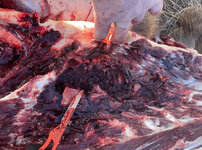
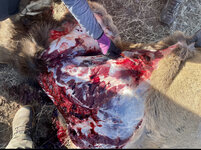
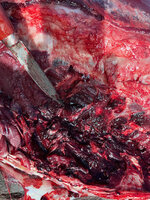
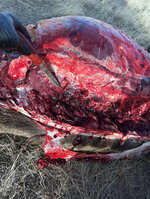
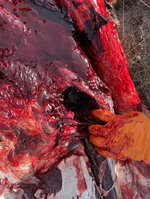
With more speed, more mass, and more frontal diameter it’s not possible for them to be the same.
Maybe our eye can’t see it due to soft tissue damage, but the 2 bullets aren’t doing the same damage to that tissue on impact at 10 feet or 1000 yards.
I'm going to take an uneducated 2 cents please.
I think that both of those bullets, impacting at optimal upset velocities (let's say 2300fps each) are going to create a temporary wound cavity that is longer than the animal is wide. Bearing in mind that there's really only a 0.044" difference in frontal diameter, i wouldn't imagine there a huge amount of measurable difference in the overall width of the stretch/temporary cavity.
The main difference is going to be in the penetration depth of each projectile & therefore the length of the permanent wound channel.
This would be noticeable in a front on, or Texas heart shot, not on a broadside, as the temporary cavity is already spanning the entire animal. With an end on shot, both bullets are penetrating deeply enough to leave a permanent channel through vital organs. I'd guess that there's maybe more likelihood of having an end on exit with the heavier bullet, but once it's permanently disrupted the vitals, that really doesn't make death any quicker, it just leaves a handy, extra trail to follow.
Tldr: There's is a difference, but animals aren't big enough for us to see it. If deer were the size of elephant, but still built like deer, it'd probably be more important. Right now, most of the bullet is going to be in the dirt before it has chance to go through all its terminal grooviness.
Something to grind your gears on. Please don't crucify me on technicalities these are hypothetical estimates.I agree, but the wound channels isn’t 35%ish bigger like people seem to think. It’s marginally bigger.
Assuming these are hollow points that will mushroom, which they are, it’s not the initial diameter, it’s the mushroomed diameter which is quite a bit larger than the initial diameter.
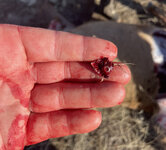
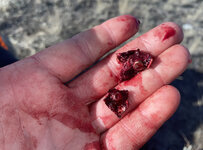
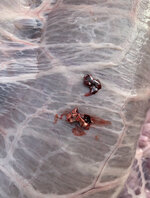
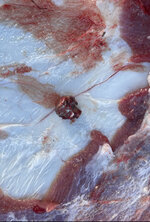
Your point about it being “good enough” might be the key. Maybe the argument isn’t that they’re the same, but instead, that the .223 and 6mm are good enough to get through an animal and the extra energy that the larger cartridge offers isn’t necessary. If that’s the case, it’s hard to disagree, but then you’d have to caveat that shot angle matters, especially on larger animals and I haven’t seen that stated.
If the stance is that the 223 works if you take into consideration shot angle, situation, and shot distance vs larger cartridges then it would be easier to wrap my head around, but that hasn’t been the message which is why it’s hard for me to get it through my thick skull.
Here are the charts.
Think like this (maybe, i dunno, I'm a dog groomer!) It's going to take longer for the 225 to reach its maximum expanded diameter than it is the 147
, as in; it needs to traverse more tissue & penetrate farther before it stops expanding.
This, i believe, is where the temporary stretch cavity transitions into the permanent wound channel. Which is probably 6-18" past the point of exit. Being that the 147 ALSO exits before reaching is full diameter (assuming the ol' advertising mushroom for both)
but being a more lightly constructed bullet it's expanding quicker in the space it has,
i would postulate that if you could take a photograph of both bullets at the exact same point, mid- animal & were able to measure the semi expanded diameter of both, I'd be very surprised if there's a measurable difference.
I spent my entire life believing that bigger animals needed bigger cartridges, until I saw that, up to a point, they very likely don't and I'm still trying to understand why.
